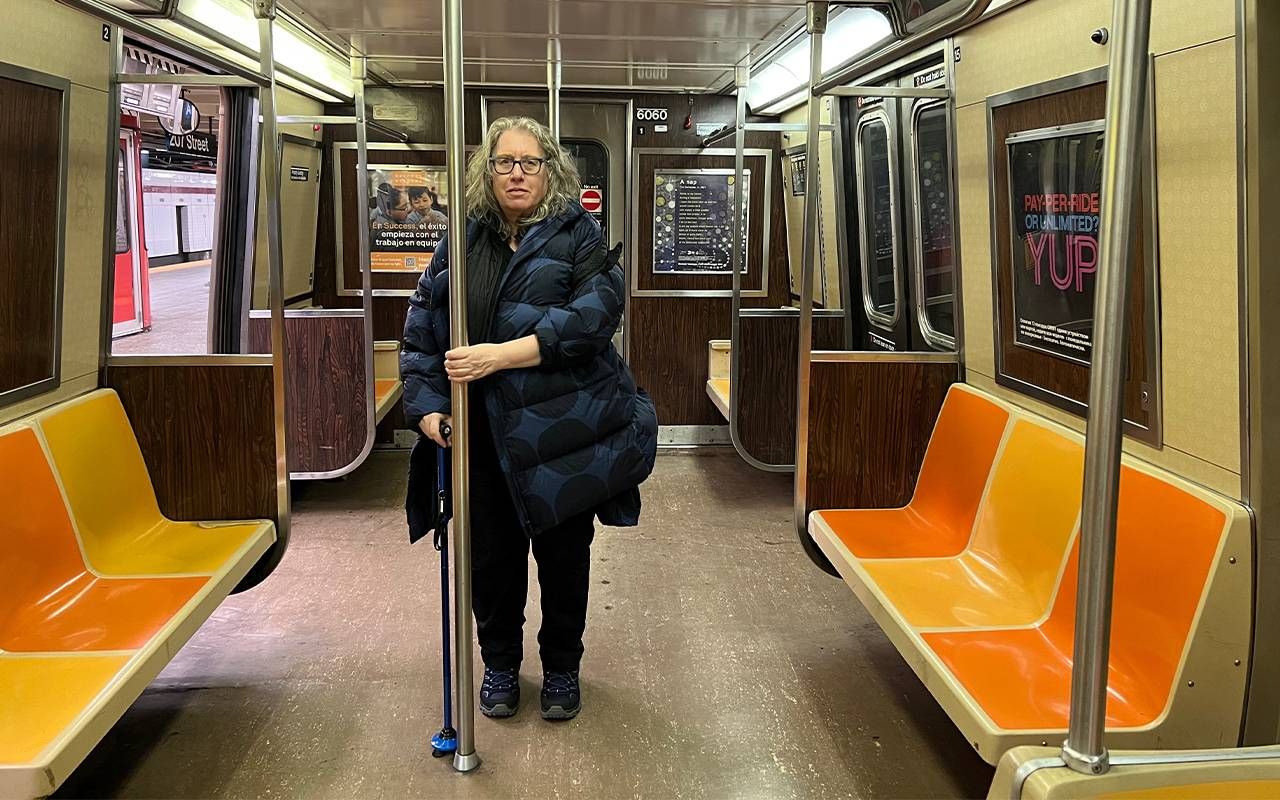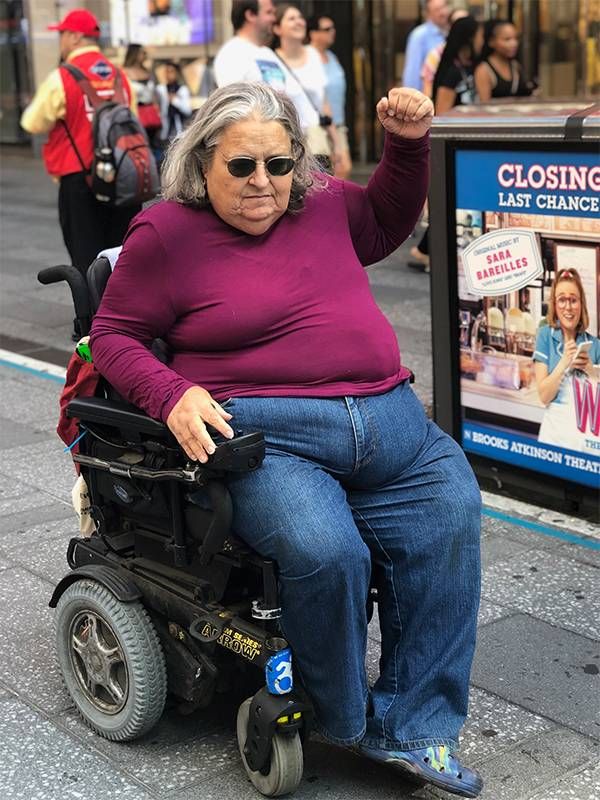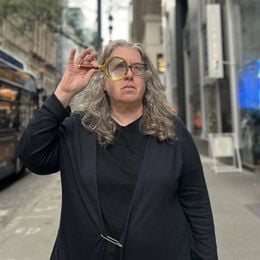My Cane Is Not A Decoration
My late friend Edith Prentiss, a disability advocate, led by example when it came to fighting for accessibility. Now I use a cane, and I've learned to channel my inner Edith.
After decades of walking miles around New York City, a herniated disc tickled my sciatic nerve, creating searing pain in my back and leg. It promptly threw me into the category of a person with a disability last fall.

I thought of my friend, disability advocate Edith Prentiss, who died at 69 in 2021. She would have carefully selected a sturdy cane, sent me on to doctors and advised me of travel routes throughout our transit system.
No matter how large or small the fight, Edith was in your corner to take on any challengers.
Edith, one of about 90,000 wheelchair users in the city, advocated for more subway elevators, lobbied for wheelchair-accessible taxis and argued for accessible voting booths. She pushed restaurant owners to include proper ramps, tables and restrooms to accommodate wheelchairs and other mobility devices.
She fought for the almost million New Yorkers who are blind or have low vision, are deaf or hard of hearing, or live with cognitive, intellectual or developmental disabilities, and those suffering from a chronic or temporary illness or injury. No matter how large or small the fight, Edith was in your corner to take on any challengers.
A film — still in progress but on hold due to my documentary film studies at Columbia Journalism School — about her life is aptly titled "Edith Prentiss: Hell on Wheels." Edith was insulted.
Fearless About Confrontation
She fumed as a step, just one step, meant the difference between entering a building, crossing a street or attending an event. Even Edith's somewhat scattered gray hair bristled. The only hair salon that fit her wheelchair in our uptown neighborhood was a spacious barber shop where Major League baseball players have their hair cut and coiffed.

Edith was fearless about confrontation. "Excuse me! Excuse me!" she would call out, digging into a mountain of tote bags attached to her wheelchair for sheaves of notes and historical records waved at elected officials, heads of city agencies and CEOs. They groaned.
Most of the time, Edith, if she didn't win the fight, made the battles for people with disabilities most visible. But once she left meetings, she became invisible. I watched people carrying shopping bags, and wheeling suitcases shove past her into subway elevators. Women pushing strollers would cut her off.
Edith would board the A Train at the George Washington Bridge bus terminal with elevators to the platform and street. It was named after her in honor of her advocacy. Only 126 of New York City's 472 subway stations have elevators or ramps. And that's if they're working. Edith was late to meetings when her elevator was out of service or missed them entirely.
Once on the train, she would pull a paperback book from her tote bags, reading as New Yorkers jostled for space. Crumbs dropped from sloppy sandwiches and landed on her lap. Splashes of coffee dripped onto her shoulders.
"Excuse me!" she yelled. "Oh, yeah. Sorry," people replied.
Edith rolled her eyes. Cranky participants dissected dangerous traffic patterns at a local community board meeting maybe a decade ago. Edith stopped the debate. "You're all just one car accident away from being like me," she warned almost gleefully, pointing to her wheelchair.
Edith was right. You never know what to expect when you step off a curb. But, years later, it wasn't a car that rendered me invisible and walking with a cane. Instead, it was my living room couch.
A Herniated Disc, A Bright Blue Walking Cane
The couch required lifting to slide a polka-dot rug under it. I picked up the couch with one hand and pushed the carpet under. No problem for a millennial with 25 years' worth of experience, although I neglected to bend my knees to absorb my weight. Bad move.
"You're all just one car accident away from being like me."
Two days later, shooting pain in my leg — so painful I could barely stand — prevented me from walking. I wanted to chop my leg off. Instead, my orthopedist sent me on my way with instructions for a cocktail of Tylenol, Advil and muscle relaxers and orders for x-rays and an MRI.
My diagnosis was confirmed after being wheeled around the hospital, peering up at people, and shoving myself onto a table to be inserted into an MRI tube — herniated disc.
A bright blue walking cane, one of the thousands pictured on Amazon, arrived the next day. Edith would have loved the flashlight attached to the handle. I imagine myself signaling her with our own personal Morse code. It wouldn't have mattered.
Channeling My Inner Edith
As they did with Edith, travelers shove past me to get onto elevators. They play Solitaire or listen to music, buried in cell phones, oblivious as I swing around subway poles practically perpendicular with pain. My gyrations are not a "showtime" performance.
I stab men in the foot with my cane so that they see me. They don't look up. Women are more often the ones who offer their seats. Then, waving my cane in the air as buses approach, I climb aboard to wedge myself between teenagers carrying sports equipment that hit my leg and business people who leap for open seats, briefcases and phones in hand.
But no matter how accessible New York City and other cities become, a person with a disability must often rely on strangers to get them through their journey.
Balancing on my cane as the bus swerves around corners would turn me into a four-eyed projectile. So, finally, I pessimistically told one bus driver, "I hope I get a seat." His reply was a dubious "Good luck with that."
Enough already with the lack of courtesy. So I channeled my inner Edith.
When I boarded the M5 bus at 59th Street several months ago, not one person rose to usher me into their seat. Every seat, including one designated for people with disabilities, was occupied by a person on their phone.
I marched to the center of the bus. "Excuse me," I called out, my voice weary with pain and annoyance. "Would someone mind giving up their seat? I have a cane. It's NOT a decoration."
A woman and her suitcase finally gave up her $2.75 seat. It was such a relief to sit.
Other times I let my eyes flutter in agony or step on someone's foot and remark, "How terrible it is to have a cane." My sneakers sometimes stick to the floors of subway elevators coated in urine, and I hold my breath against the stench. On my way to and from the subway, I hop over puddles of dog pee and piles of poop, spraying Lysol on my shoes and cane to disinfect them when I return home.
How Do You Get People to Care?
Using a cane made me finally understand Edith's frustration. So how do you get people to care?
Change is slow. The Metropolitan Transit Authority, which operates NYC's subways and buses, announced in June 2022 that elevators and ramps would be added to 95% of subway stations as part of a settlement agreement in two class-action lawsuits — by 2055.
But no matter how accessible New York City and other cities become, a person with a disability must often rely on strangers to get them through their journey, to give up a much-needed seat, to let them board an elevator, to open a door, to realize that maybe they can use a little extra space to get around.
Look up from cell phones to see who's struggling to stand. We can all do better. Now, here's my bus. My inner Edith is prepared to remind people that I have a cane. It's not a decoration.


